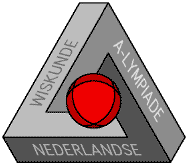 Math A-lympiad: Preliminary
1991-1992
Math A-lympiad: Preliminary
1991-1992  Math A-lympiad: Preliminary
1991-1992
Math A-lympiad: Preliminary
1991-1992 The National Science Museum was set up with funds from the European Community, the Ministries of Education and Science and Economic Affairs, and Dutch industry. Its purpose is to bring science and technology closer to the people. A secondary aim is to interest more schoolchildren in technical studies.
Every week the Science Museum receives dozens of groups of schoolchildren. Each group has a guide who accompanies the group for the whole day. To this end the museum currently has eight permanent guides in service. There are also 15 stand-by guides who can be called in on busy days. There have been a couple of occasions when there have been too few guides, and members of the scientific staff have had to step in. At the moment, the arrangement is that if notice of 2 days is given before the arrival of a group of schoolchildren a guide will always be available.
The full-time guides are currently employed according to a fixed roster. They
always work seven consecutive days on and three days off. Other service rosters
may be discussed but they could have financial implications.
Recently the situation where more than half of the guides are stand-by staff
has been occurring more frequently. As stand-by staff are more expensive than
full-time staff, they have been considering expanding the number of full-time
staff.
Over the last eight weeks they carefully recorded how many groups of schoolchildren visited the science museum.
| Week | Mon | Tue | Wen | Thu | Fri | Sat | Sun |
|---|---|---|---|---|---|---|---|
| 1 | 6 | 9 | 12 | 11 | 12 | 9 | 5 |
| 2 | 7 | 7 | 13 | 10 | 13 | 8 | 8 |
| 3 | 9 | 10 | 14 | 11 | 15 | 7 | 7 |
| 4 | 5 | 8 | 11 | 9 | 17 | 10 | 11 |
| 5 | 4 | 9 | 15 | 10 | 10 | 8 | 4 |
| 6 | 7 | 6 | 14 | 7 | 15 | 11 | 8 |
| 7 | 8 | 11 | 16 | 12 | 9 | 9 | 7 |
| 8 | 7 | 8 | 13 | 9 | 14 | 5 | 9 |
In this period they also recorded how many stand-by staff were called by phone, how many could be reached, and how many were ultimately available.
| called | reached | available |
|---|---|---|
| 426 | 315 | 226 |
If a stand-by worker does not answer the phone, the next on the list is called.
It is thus not known whether a second attempt would be successful. It is also
not known whether one stand-by worker is available more often than another.
(According to an agreement the stand-by staff must be called in rotation. For
example, if today stand-by worker 5 is the last to be called, tomorrow No. 6
will be called first).
The wage and salary costs vary. A full-time guide costs around 50.000 guilders
per year including employer contributions. A stand-by worker receives 300 guilders
for each day of work. A member of the scientific staff costs the museum around
80.000 guilders per year.
Exercise
The museum is not satisfied with the current situation and went to a consultancy
to examine a more cost efficient organization regarding the guides. With regard
to questions on sick leave and holidays it was said that absenteeism is quite
low, around 4%, and that holidays do not play a role because guides have to
let their holidays coincide with the school holidays.
It was agreed first to endeavor to draw up a more efficient service roster.
After that they would then examine whether expanding the number of full-time
guides was still sensible.
You must produce this advice. Remember that the information given is rather
brief. Your advice cannot be the optimum solution but it must contain a properly
constructed proposal for improvement. If you believe that the information given
is insufficient or insufficiently reliable than you must specify in your advice
what additional information is needed to improve the quality of the advice.